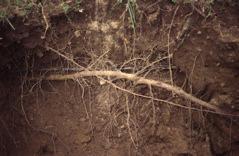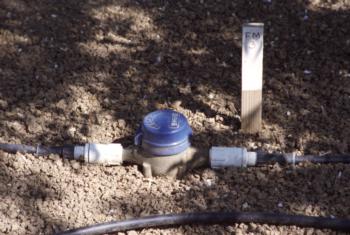Drip tubing SDI systems
Subsurface drip irrigation (SDI) drip tubing microirrigation systems are most commonly used for tree and vine (permanent) crops. These systems come in a variety of designs so it is difficult to provide evaluation guidance that applies to all installations. One characteristic that is common to most drip tubing SDI systems is that the lateral line ends are exposed for ease of flushing, making it easy to take pressure measurements there using a pressure gauge equipped with the appropriate drip fitting. Sometimes the heads of the laterals are exposed as well and pressure measurements and flow rate measurements can be taken there.

Pressure measurements
Drip tubing SDI systems frequently operate at higher pressures than do drip tape systems. Usually the pressure is below 30 psi, but not always, so a 0 to 60 psi pressure gauge is appropriate. As mentioned previously, the lateral line end is often exposed to permit flushing, allowing pressure measurements to be taken at the lateral ends. If the head of the lateral is exposed, pressure measurements can also be taken there.
A non-pressure-compensating (NPC) drip tubing system that has limited pressure variability (less than 10 to 20%) should apply water uniformly unless it is affected by emitter clogging. Pressure compensating (PC) drip tubing systems, in the absence of clogging, should be applying water uniformly so long as the operating pressure remains above a minimal threshold (see the manufacture's technical information for this threshold), even if there are significant variations in pressure.
Discharge rate measurements
Flow meters
Two flow meter options are available for measuring discharge rates in the drip tape laterals. First, a single flow meter installed at the head of the system can measure the total flow. If pressure is held constant, an increase in flow rate may indicate leaks in the system. Similarly, a decrease in flow rate over time may be indicative of clogging. One disadvantage of using a single flow meter is that if pressure readings indicate a problem, the single meter does not indicate where in the system the problem is occurring.

Keeping records of flow rate measurements over time (daily, weekly, monthly), all taken at the same operating pressure, can be critical to determining whether clogging is occurring in an SDI system. Pressure measurements will not provide information on clogging, but flow rate decline over time can be very helpful in identifying clogging problems. If your measurements indicate that there is a clogging problem, click here:
"I have a Clogging Problem and I Want to Solve It”.
Direct Discharge Rate Measurements
Since the hard tubing SDI systems are buried, often 12 inches or more deep, direct measurement of emitter discharges is not practical.
